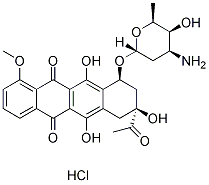| Cas No.: | 23541-50-6 |
| Chemical Name: | Daunorubicin hydrochloride |
| Synonyms: | Daunomycin hydrochloride; daunomycin HCl; daunorubidomycine; US brand names: Cerubidine; Rubidomycin; Foreign brand names: Cerubidin; Daunoblastin; Daunoblastina; Ondena; Rubilem; Abbreviations: DNM; DNR; DRB; Code names: FI6339; RP13057. |
| SMILES: | O=C(C(C(OC)=CC=C1)=C1C2=O)C3=C2C(O)=C(C[C@@](O)(C(C)=O)C[C@@H]4O[C@@]5([H])C[C@H](N)[C@H](O)[C@H](C)O5)C4=C3O.[H]Cl |
| Formula: | C27H30ClNO10 |
| M.Wt: | 563.98 |
| Sotrage: | 2 years -20°C Powder, 2 weeks 4°C in DMSO, 6 months -80°C in DMSO |
| Description: | Daunorubicin hydrochloride is a topoisomerase II inhibitor with potent antineoplastic activities. |
| In Vivo: | Urinary protein excretion, serum creatinine, and blood urea nitrogen (BUN) level are significantly increased in group Daunorubicin (3 mg/kg, i.v.) compared with those in group Control. Administration of Daunorubicin (DNR) causes a significant increase in malondialdehyde (MDA) level in renal tissue compared with that in the control group[4]. |
| In Vitro: | The mean IC50 value is 0.04 μM for Daunorubicin (Dnr) in Molt-4 cells. Daunorubicin belongs to the anthracyclines, a group of cytotoxic chemotherapeutics. The cytotoxic effects of anthracyclines are caused by DNA intercalation and the ability to interfere with DNA transcription and replication by inhibiting Topoisomerase II as well as by producing reactive oxygen species[2] Daunorubicin inhibits of both DNA and RNA syntheses in HeLa cells over a concentration range of 0.2 through 2 μM. The IC50 value is 0.4 μM for Daunorubicin (Dnr) in human pancreatic cell line L3.6[3]. |






















